Introduction
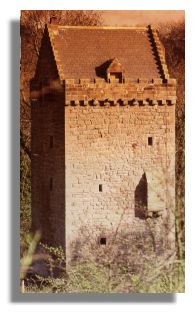 Scotland may be a small country in comparison with other great nations and continents, but what we may lack in territory, we make up for through breathtaking natural beauty and a unique and unspoilt sense of the past.
Scotland may be a small country in comparison with other great nations and continents, but what we may lack in territory, we make up for through breathtaking natural beauty and a unique and unspoilt sense of the past.
A long and turbulent history, protecting and defending the land from invasion, has left a rich and romantic heritage of ancient kirks, the ruins of abbeys, grand cathedrals, medieval castles and towers.
There is something exquisitely magical and mysterious about visiting a truly old and original castle or fortified tower; the experience of walking on and touching thick slabs of granite or sandstone, which have been weathered by centuries of sun, wind and rain; climbing steep spiral staircase with tiny arrow slit windows giving just an inch of sunlight; stand on the battlements and survey the landscape from the Look Out tower; perhaps it all reminds us of childhood fairy tales and stories - From her high turret Rapunzel letting down her long, golden hair for her prince, or the Sleeping Beauty, and knights in shining armour.
But myths and legends aside, Scotland offers a real taste of living history, and reminds us of the vital importance to protect and preserve buildings of great architectural and historical importance. Across the length and breadth of the country, apart from such famous Castles as Edinburgh and Stirling, you can visit hundreds of fascinating fortifications, some preserved and renovated, such as the imposing Neidpath Castle on the banks of the Tweed, near Peebles, others in ruins, but equally dramatic, such as Crichton Castle, Pathhead or Tantallon, near North Berwick.
Visiting such ancient dwellings for an afternoon is the normal experience, but to stay there, overnight, is, as you might imagine, very unusual.
Tower of Hallbar
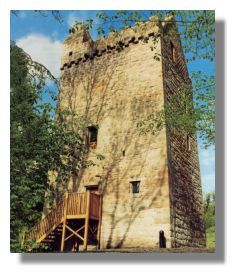 The Tower of Hallbar, in the Clyde Valley, is a stunning, sixteenth century fifty-eight foot Tower complete with turreted battlements, dovecote, gargoyles, which, unbelievably, can be yours to rent for a long weekend, a week, - or even longer.
The Tower of Hallbar, in the Clyde Valley, is a stunning, sixteenth century fifty-eight foot Tower complete with turreted battlements, dovecote, gargoyles, which, unbelievably, can be yours to rent for a long weekend, a week, - or even longer.
As one previous visitor observed, "This is a wonderful, unusual house, combining ancient grandeur with modern luxuries".
And that is exactly what you will find if you make your way south of Glasgow, following the Clyde Valley, away from the industrial belt, and abandoned coal mines, past the towns of Motherwell and Hamilton and on to the pretty country lanes and villages of South Lanarkshire. In less than an hour you will come across the tiny hamlet of Crossford, turn left at the bridge and follow the B7056 up the steep winding hill.
With clear directions on how to get there, we began to look out for the signpost to the right. Even though I had seen many a photograph of the Tower of Hallbar, to suddenly catch a first glimpse of it looming above the trees this was a truly awesome sight - almost eerie, dramatic, magical. "Oh, my goodness," we all seemed to shout out in unison, "There it is!" We turned down the drive, opened the gates and drove majestically into the grounds and pretty gardens of the estate. Ahead of us stood the most impressive five-storey Tower as well as a garden cottage, which has been completely adapted for a wheelchair access and disabled guests.
Already it was exciting to imagine what it was going to be like to live here - but both the Tower and the cottage were to be our private home for the next few days.
Vivat Trust
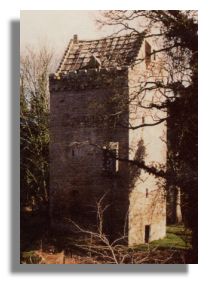 It was just one year ago, in May 2000, when the Scottish television presenter, Kirsty Wark was the guest of honour at the opening celebrations of the Tower of Hallbar.
It was just one year ago, in May 2000, when the Scottish television presenter, Kirsty Wark was the guest of honour at the opening celebrations of the Tower of Hallbar.
"This is a great day because I remember the tower being derelict when I used to come here. To welcome people here from all over the world is absolutely fantastic."
This marked the completion of a five year project by the Vivat Trust, a remarkable and vital charity dedicated to rescuing, preserving and renovating important listed properties of architectural and historical importance which have fallen into serious disrepair through long term neglect. Funding was raised through the Heritage Lottery Fund, Historic Scotland, Lanarkshire Development Agency and local government as well as other public and private grants.
The restoration has been most sensitively and tastefully thought out, with careful structural repairs to secure the ancient walls, using local aggregates to march the historical composition of the original lime mortar. The roof was rebuilt replacing the broken and missing stone slabs with traditional Westmorland slates. Doors and windows were reinstated to match original architectural features and to improve weather-tight protection. Inside walls were renovated using lime plastering with added horsehair for extra strength.
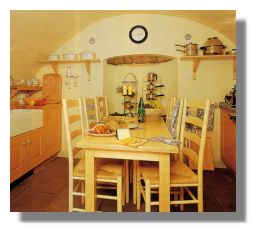 Inside the fittings and furnishings have been selected with the utmost attention to quality and artistic detail. The groundfloor cellar, previously used it is believed for storage or winter shelter for the animals, is now a most attractive "farmhouse" style kitchen-dining room.
Inside the fittings and furnishings have been selected with the utmost attention to quality and artistic detail. The groundfloor cellar, previously used it is believed for storage or winter shelter for the animals, is now a most attractive "farmhouse" style kitchen-dining room.
It is extremely functional, with every possible modern convenience, - neat pine-wood cupboards, gleaming stainless steel pots and pans, pretty Blue Denmark china, old fashioned white sink, coffee makers, blender, electric kettle and toaster, all top quality design, including essential cork screws, garlic press, and even a dishwasher. Yet this modern-day practical kitchen, is built within a vaulted chamber with a very low entrance archway and thick cellar stone walls, and so still very much imbues a sense of the age and ambience of this ancient old property.
When you start climbing - slowly - up the steep, stone stairs to the first floor, the exciting novelty of staying in a real Tower quickly sinks in. While the steps have been repaired and replaced where necessary, the original uneven surface and height of them have been purposely left intact. So clambering up one flight you reach the Great Hall - a truly sumptuous and cosy living room. Remembering to duck your head on entering the typical low door, the room has been beautifully furnished with period armchairs and high packed Jacobean style upholstered couches. The furniture is all in the traditionally dark oak and mahogany, the fabrics - soft and thick velvets and brocade in rich terracotta and crimson.
The ceiling features the old oak beams as well as beautiful heraldic emblems and paintings, which were recently cleaned and restored by June McEwan using authentic earth pigments, ox gaul bound by rabbit skin glue; there is a broad open fireplace, with logs and fuel supplied to burn on cold days and winter nights. There are attractive antique tables and chests, and thick rugs underfoot over the timber floors. Opposite the fire is a window seat, set within the thick 3 foot stone wall recess. Jugs of flowers from the garden and tall candlesticks add a delightful and romantic touch.
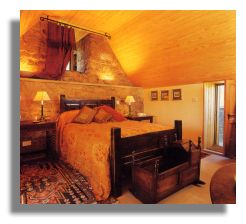 Pausing for breath now climb to the second floor and the first bedroom, a most charming intimate room with a single bed. Next door the bathroom, fitted with hot and cold running water, and every modern convenience thankfully added in the interior renovation.
Pausing for breath now climb to the second floor and the first bedroom, a most charming intimate room with a single bed. Next door the bathroom, fitted with hot and cold running water, and every modern convenience thankfully added in the interior renovation.
The alternative would be to use the "garderobe", the lavatory, built during the Victorian period and still present today, a kind of closet projecting out from the wall on stone corbels - (the supports).
The stair case - described as a dog-leg design - runs up the four storeys inside the five foot exterior wall. It now moves to the other side of the Tower, as the continuous passage up from the ground floor is now interrupted by the Hall chimney. A particularly steep and vertical flight of steps takes us to the third floor and a spacious double bedroom. Here there are two lovely "Snow White and the Seven Dwarfs" type beds with carved wooden boards at head and foot. Again the furnishings and fabrics are of superb quality, with pretty bedspreads in soft grey and fawn. The roof is vaulted, creating a most unusual rounded shape to the bedroom. The walls may be of thick stone slabs but with polished wood flooring, rugs, and adequate heating, one thing that has not been preserved is the damp, bitter cold which would have been experienced by previous inhabitants.
But our tour of the tower is not yet over. Up we go again, and the final flight of the dog-leg staircase ends with an arched wooden door leading directly outside onto the battlements surrounding the Turret at the top with its pyramidal slate roof. But walking along these external path ways, is not as precarious as one might imagine, as the top of the walls rise perhaps around five feet, with very little danger of falling over.
Half way along the battlements is another door, leading to the fabulous Turret or attic bedroom. This is thought to have been used as a guardsroom and a store for weapons. Now the room features an enormous antique oak double bed, covered in ivory silk bedlinen. Velvet curtains on a brass rail can be drawn across the south facing oriel window, which projects out on three corbels in the gable. This is placed strategically high up under the roof and was the old watch tower for observing uninvited guests approaching in the distance.
On the North gable a grid system of square pigeon holes can still be seen from the outside, built in line with the chimney, to ensure the birds were kept warm. Formerly a door from the Turret led onto a timber platform giving access to this original Dovecot - a useful supply of food in winter months or in the case of a blockade.
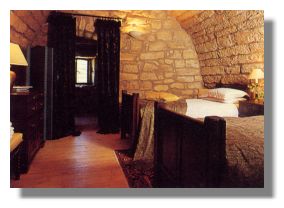 Sleeping up in the Turret bedroom is an incredible experience, right at the top of the Tower. Romantic, a wee bit scary, but utterly atmospheric. In my dreams I was Rapunzel with my prince come to rescue me from the wicked witch!
Sleeping up in the Turret bedroom is an incredible experience, right at the top of the Tower. Romantic, a wee bit scary, but utterly atmospheric. In my dreams I was Rapunzel with my prince come to rescue me from the wicked witch!
One thing you may want to ensure is that you don't have to make a trip in the early hours of the morning out into the night air and down two flights of chilly stone steps to the bathroom. (Note: In emergency there are old Victorian porcelain "pots" under the bed!)
And we slept soundly with no sight nor sound of any ghosts.
Surroundings
The Tower is set in five acres of natural woodland, newly planted orchards and meadows. The lawns and gardens immediately surrounding the Tower are very pretty and colourful with an abundance of red and yellow poppies, cow parsley and purple thistles. Here at the side of the Tower is the garden furniture - a large refectory style table and eight chairs - perfect for an alfresco Summer lunch or supper party. We enjoyed sitting here at sunset, with a chilled drink in hand, the scent of the meadow-flowers all around, birds and butterflies swooping and darting through the trees. The natural wildlife around here is meant to be particularly interesting with badger sets nearby and grazing deer.
In the garden there is also a hammock for a very relaxing 'swing', for those who dare to get in - and out - of it and also an outdoor table tennis table for the energetic. But the peace and tranquility, amidst this dramatic and historic setting is simply the perfect haven to get away from it all, and take time out - literally - in a time zone all of its own.
"We actually came on our honeymoon!. The Tower and its ambience will remain with us forever. We will be back!."
Mr and Mrs. Ian Leybourne.



